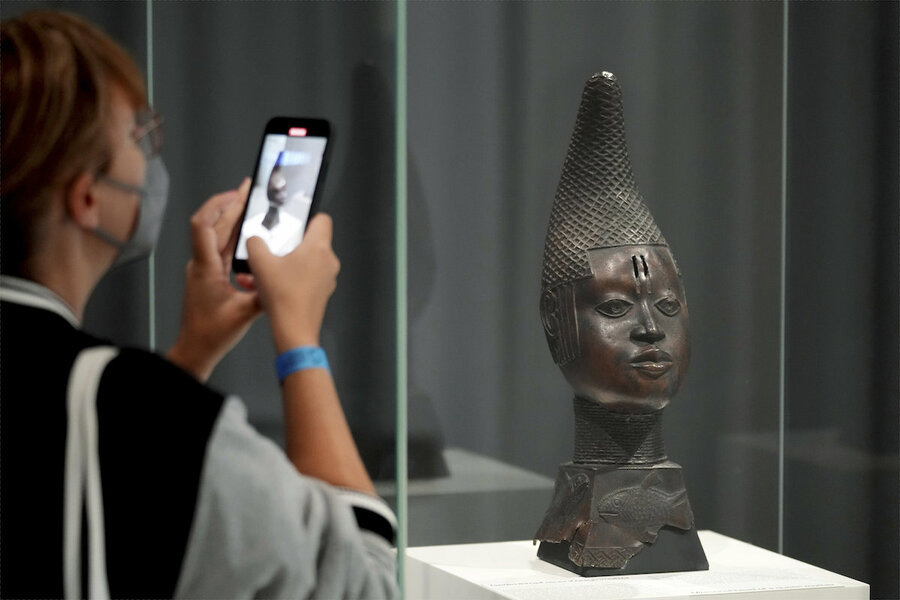Berlin museum displays transparency alongside pillaged artifacts
Loading...
| Berlin
A Berlin museum opens fully to the public this week with a very modern take on the display of cultural items from around the world and the debate over demands for some of them to be returned to their homelands.
The east wing of the Humboldt Forum contains items from the city’s Ethnological Museum and the Museum for Asian Art. It will display some 20,000 objects, among them dozens of Benin Bronzes that were stolen in Africa during colonial times – as well as an exhibit explaining to visitors how most of them are soon to return to Nigeria.
The east wing opened Thursday with a preview for reporters and will be open to the public starting Saturday. The west wing of the museum – located in the heart of the German capital, next to the neoclassical Museum Island complex – opened in 2021. It also contains items from the two collections.
The objects on display offer a survey of the world’s cultures and have been chosen to place a new emphasis on the importance of art from Africa, Oceania, Asia, and the Americas.
During the development of the exhibition, German curators worked closely together with teams from countries and regions where many of the objects originated.
“It was important for us to develop the narratives of these objects in cooperation with colleagues from all over the world,” said Hermann Parzinger, the president of the Prussian Cultural Heritage Foundation, an authority that oversees many of Berlin’s museums including the Humboldt Forum.
“This house was created through dialogue and exchange,” Mr. Parzinger added. “Our commitment to openness and transparency, the recognition of colonial injustice with resulting restitutions ... will continue to define our work in the future.”
Earlier this year, Germany and Nigeria signed an agreement about the return of 514 objects from the famous Benin Bronzes collection that were looted from the royal palace of the Kingdom of Benin, in what is now southern Nigeria, by a British colonial expedition in 1897.
The artifacts ended up spread far and wide. Hundreds were sold to collections such as the Ethnological Museum in Berlin, which has one of the world’s largest groups of historical objects from the Kingdom of Benin. Many of them date from the 16th to the 18th centuries.
While the first pieces will be returned to Nigeria later this year, about a third of the collection will remain on loan in Berlin for an initial period of 10 years.
In one of the galleries, 40 of the Benin Bronzes will be presented at the opening. They include iconic cast bronze memorial heads, carved ivory tusks, and rectangular relief plaques.
A second gallery is dedicated to illustrating the restitution process. In video installations, German and Nigerian scholars, artists and representatives of museums, and the royal family in Benin City explain from multiple perspectives the history and significance of the objects and give their view on the current restitution debate.
Other objects that will be on display include a sixth-century Buddhist cave temple from Kizil, located near Kucha on the Northern Silk Road in China, an exhibition of textiles and pottery from Central Asia, and traditional buildings and houses from different regions in Oceania such as a meeting house from Palau from 1907, as well as a replica of an Abelam cult house from Papua New Guinea.
Several galleries are dedicated to art from the Americas. Among the highlights are large stone reliefs from the Aztecs, and a 16-square-meter (172-square-foot) painted cloth with inscriptions by Mixtec, Nahuatl, and Choco artists from what is now the Mexican state of Oaxaca, which records social events spanning a period of more than 500 years.
In addition to the permanent exhibitions, there will be changing temporary exhibits.
Among those shown during the opening of the museum, is a collection of around 60 objects that was compiled by Francis La Flesche, a Native American ethnologist who was born on the Omaha Reservation in the United States’ Midwest in 1857. Mr. La Flesche collected the items, such as clothes, decoration, and ornaments on behalf of the Ethnological Museum in the 19th century hoping to preserve parts of his culture this way.
All in all, the collections of the Ethnological Museum and the Museum for Asian Art comprise about 500,000 objects, which were previously shown in museums in the city’s Dahlem district. Less than 3% will be on display in the Humboldt Forum.
Since the opening last year of the west wing of the Humboldt Forum – which is a partial replica of a Prussian palace that was demolished by East Germany’s communist government after World War II – more than 1.5 million people have visited.
Entrance to the museum will be free at least until the end of this year.
This story was reported by The Associated Press.







